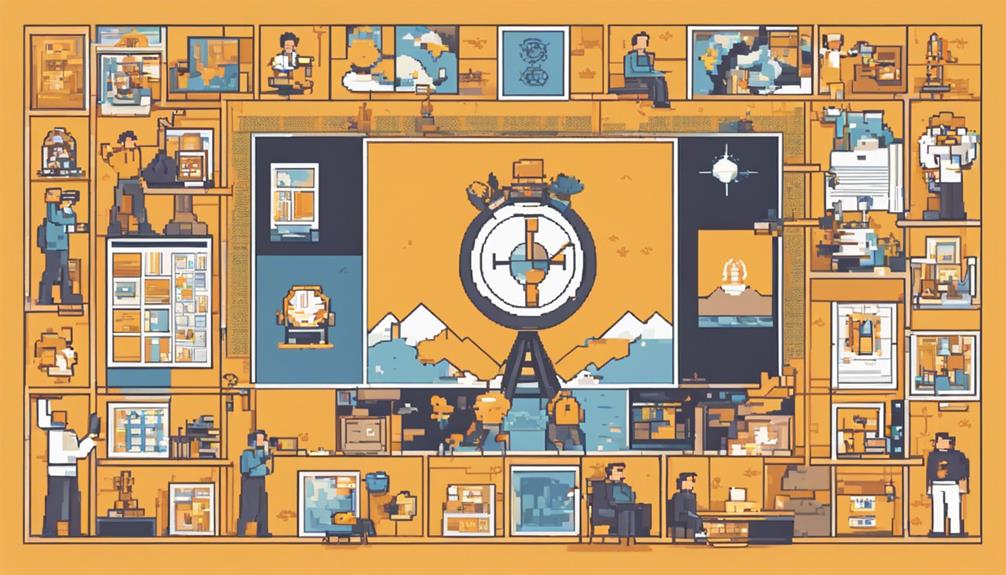Self-Improvement and Motivation
Emerging Tech Trends Shaping Our Future
Explore the latest technology trends poised to transform our daily lives and industries. Stay ahead with insights on what’s shaping the future.

In the ever-evolving landscape of technology, staying ahead of the curve is vital for businesses, governments, and individuals alike. To help you navigate this dynamic realm, we’ve compiled a comprehensive exploration of ten strategic technology trends that are shaping the future. These trends encompass the fields of artificial intelligence (AI), cybersecurity, biotechnology, immersive experiences, and more.
From the mind-bending possibilities of quantum computing to the transformative potential of biotechnology, these emerging tech trends hold the key to unlocking a world of innovation and progress. But what exactly are these trends? How will they impact our lives? And how can we leverage them to stay at the forefront of change?
In this article, we delve deep into each trend, exploring their applications, benefits, and challenges. Get ready to embark on a journey of technological discovery as we explore the exciting future that awaits.
Key Takeaways:
- Stay ahead of the curve by embracing emerging technology trends.
- Ten strategic trends are shaping the future in fields such as AI, cybersecurity, and biotechnology.
- Quantum computing, biotechnology, and immersive experiences are just a few trends to watch.
- Explore the applications, benefits, and challenges of each trend.
- Prepare for the future by leveraging these trends to innovate and progress.
Explainable AI (XAI)
Explainable AI (XAI) is a critical aspect of artificial intelligence (AI) that seeks to enhance the transparency and interpretability of AI systems. XAI techniques enable users to comprehend and trust AI-driven predictions by offering transparent explanations for model outputs. This fosters a deeper understanding of how AI systems arrive at their conclusions, empowering users to make more informed decisions based on the provided insights.
One of the key challenges that AI systems face is their lack of explainability, which can lead to skepticism and mistrust. Through XAI, AI transparency is improved, allowing users to understand the reasoning behind AI-generated results. By unboxing the complex inner workings of AI models, XAI provides vital context and explanation, bridging the gap between advanced AI algorithms and human comprehension.
XAI’s applications span various domains, including healthcare, finance, and customer service, among others. In healthcare, for instance, explainable AI ensures that AI systems not only provide a diagnosis but also explain the specific features they considered to reach that conclusion. This helps medical professionals gain confidence in AI-driven recommendations, enabling them to make more informed decisions about patient care.
Additionally, XAI plays a crucial role in facilitating AI compliance with ethical and regulatory standards. It allows organizations to demonstrate accountability and maintain transparency by providing auditable and understandable explanations for AI recommendations. This is particularly important in sectors where transparency and explainability are paramount, such as finance and legal enforcement.
In summary, explainable AI is instrumental in enhancing the transparency, trust, and interpretability of AI systems. By providing transparent explanations for AI outputs, XAI empowers users to understand and trust the decisions made by AI models. This not only enables more informed decision-making but also addresses concerns surrounding ethical and regulatory compliance in the deployment of AI technologies.
“Explainable AI is a crucial step towards building trust in AI systems and promoting AI transparency.” – Dr. Emily Lee, AI Researcher
Benefits of Explainable AI:
- Enhances transparency and interpretability of AI systems
- Promotes trust and confidence in AI-driven predictions
- Empowers decision-makers with contextual insights
- Ensures compliance with ethical and regulatory standards
- Fosters accountability in AI deployment
As the adoption of AI systems continues to grow, the demand for explainable AI solutions becomes even more critical. By leveraging the power of XAI, organizations can unlock the full potential of AI while promoting transparency and building trust with their users and stakeholders.
Zero Trust Security
Zero Trust Security is a paradigm shift in cybersecurity that emphasizes continuous verification of users and devices, regardless of their location or network connection. This approach creates a security perimeter around every device and user, reducing the risk of data breaches.
Traditionally, network security relied on a perimeter defense strategy, assuming that devices within the network were trustworthy. However, with the increasing number of sophisticated cyber threats, this approach has proven inadequate, leaving organizations vulnerable to attacks.
With Zero Trust Security, organizations adopt a proactive approach that treats every device, user, and network connection as potentially untrusted. The key principle is to verify and authenticate every interaction, ensuring that only authorized users and devices gain access to sensitive data and resources.
“Zero Trust Security follows the principle of ‘never trust, always verify.’ It requires organizations to validate and authenticate every request, whether it’s internal or from external sources. By eliminating implicit trust and implementing strict access controls, Zero Trust Security significantly reduces the attack surface and improves overall cybersecurity posture.”
A company implementing Zero Trust Security continuously verifies every employee, reducing the risk of unauthorized access to sensitive data. This approach safeguards against various cyber threats, including insider attacks, compromised credentials, and lateral movement within the network.
Implementing Zero Trust Security involves several key components:
- User and device identity management
- Continuous authentication and authorization
- Microsegmentation
- Least privilege access controls
- Real-time monitoring and threat detection
- Data encryption and data loss prevention
By implementing these measures, organizations can establish a robust network security framework that aligns with the Zero Trust Security model, effectively mitigating risks and protecting critical data.
As cyber threats continue to evolve, zero trust security has emerged as a crucial strategy for organizations across industries. It offers a proactive defense mechanism against modern cyberattacks and enhances the overall resilience of a company’s cybersecurity infrastructure.

Biotechnology Advancements
Biotechnology is a rapidly advancing field that encompasses innovations in biology and genetics. One of the most transformative advancements in biotechnology is CRISPR-Cas9, a groundbreaking gene-editing technology.
CRISPR-Cas9 allows scientists to make precise modifications to DNA, opening up new possibilities in various fields such as medicine, agriculture, and environmental conservation. With its ability to edit genes, CRISPR-Cas9 has the potential to revolutionize healthcare and address genetic diseases.
“CRISPR-Cas9 is a game-changer in biotechnology. It’s like a pair of molecular scissors that can cut and alter DNA with incredible precision,” explains Dr. Jane Evans, a renowned geneticist.
In medicine, CRISPR-Cas9 holds immense promise for treating genetic diseases by directly editing the patient’s DNA. This technology has the potential to cure previously untreatable diseases, offering hope to millions of individuals worldwide.
Moreover, CRISPR-Cas9 also plays a crucial role in agriculture. By modifying the genetics of crops, scientists can enhance their yields, improve disease resistance, and create more sustainable farming practices. This has significant implications for food security and environmental sustainability.

The impact of CRISPR-Cas9 extends beyond medicine and agriculture. It is being explored for environmental conservation, with the potential to address challenges such as species preservation and ecosystem restoration. By modifying the DNA of endangered species, scientists hope to mitigate the effects of habitat loss and climate change.
Applications of CRISPR-Cas9
Here are some specific applications of CRISPR-Cas9 in various fields:
- Treatment of genetic diseases through targeted gene editing.
- Development of genetically modified crops with improved traits.
- Creation of disease models for research and drug discovery.
- Identification and targeting of specific cancer-causing genes.
- Potential for restoring extinct species through genetic engineering.
Limitations and Ethical Considerations
While CRISPR-Cas9 holds immense potential, there are also ethical considerations and limitations that need to be addressed. The technology’s precise nature raises concerns about unintended consequences and the potential for misuse. There are ongoing debates surrounding the ethical implications of modifying the human germline and the need for global regulations to ensure responsible use of this technology.
| Advantages | Challenges |
|---|---|
|
|
Despite these challenges, the development of CRISPR-Cas9 demonstrates the incredible potential of biotechnology in shaping our future. As scientists continue to refine and expand its applications, we can expect further breakthroughs and a deeper understanding of genetics and biology.
Experiential Marketing through Immersive Technologies
Experiential marketing has undergone a transformative shift with the integration of immersive technologies such as augmented reality (AR) and virtual reality (VR). These cutting-edge technologies have revolutionized the way businesses engage with their customers, offering interactive and unforgettable experiences.
Augmented reality enables customers to visualize products in their real environment, providing a unique and immersive experience. Retailers, for instance, leverage AR apps to enhance customer engagement by allowing them to virtually try on clothing or visualize furniture placement in their homes. This experiential approach not only aids customers in making more informed purchasing decisions but also fosters a deeper connection between the brand and the consumer.
Virtual reality is another powerful tool in experiential marketing, transporting users to virtual worlds and creating impactful brand experiences. With VR, brands can immerse customers in virtual scenarios that evoke emotions and generate lasting impressions. For instance, a travel agency can use VR to provide customers with virtual tours of popular destinations, helping them visualize the vacation experience beforehand.
Integrating augmented reality and virtual reality into experiential marketing strategies opens up a world of possibilities, offering unique opportunities for businesses to engage with their target audience. Whether it’s allowing customers to try on products virtually, explore virtual environments, or interact with digital elements in the real world, these immersive technologies are revolutionizing the way brands connect with their customers.
“Immersive technologies like augmented reality and virtual reality are game-changers in the world of experiential marketing. They provide brands with the ability to create memorable experiences that leave a lasting impact on customers.”
Benefits of Experiential Marketing through AR and VR:
- Enhanced customer engagement and interaction
- Improved brand recognition and recall
- Increased customer satisfaction and loyalty
- Opportunity for innovative storytelling and brand narratives
- Ability to visualize products and services in real-world contexts
Case Study: Lenovo’s Virtual Reality Pop-Up Shop

| Challenge | Solution | Results |
|---|---|---|
| Lenovo wanted to showcase their VR gaming laptops to a wider audience. | Created a virtual reality pop-up shop where customers could experience gaming laptops in virtual gaming environments. | Increased interest in Lenovo’s VR gaming laptops, leading to a spike in sales and brand visibility. |
Lenovo, a leading technology company, utilized virtual reality in a pop-up shop concept to immerse customers in gaming experiences and showcase their VR gaming laptops. Visitors could don VR headsets and engage in virtual gaming scenarios, enabling them to experience the power and capabilities of Lenovo’s gaming laptops firsthand.
“The virtual reality pop-up shop allowed us to provide customers with an immersive and unforgettable experience. It created a buzz around our VR gaming laptops and significantly boosted sales.”
This innovative approach to experiential marketing exemplifies the power of augmented reality and virtual reality in creating engaging brand experiences that resonate with customers, driving brand awareness and loyalty.
Exoskeletons and Human Augmentation
Exoskeletons and human augmentation technologies are wearable devices that enhance human capabilities. They are designed to alleviate physical strain and improve the quality of life for individuals in various industries such as manufacturing and healthcare. By providing additional strength and support, these devices can reduce the risk of injury and enhance productivity.
In the manufacturing industry, exoskeletons are worn by workers to assist in heavy lifting and repetitive tasks. These devices can bear the weight of heavy objects, reducing the strain on the worker’s body and minimizing the risk of musculoskeletal disorders. With the help of exoskeletons, workers can perform their tasks more efficiently and with reduced physical exertion.
In the healthcare sector, exoskeletons play a crucial role in rehabilitation and mobility for individuals with disabilities. These devices can provide support to patients with limited mobility, allowing them to regain their independence and perform daily activities with greater ease. Exoskeletons are also used in physical therapy to aid in the recovery process for patients with orthopedic or neurological conditions.
Human augmentation technologies encompass a range of wearable devices that enhance various human functions. From prosthetic limbs to assistive devices for individuals with impaired vision or hearing, these technologies have the potential to greatly improve the quality of life for people with disabilities.
In addition to assisting individuals with physical limitations, human augmentation technologies also have applications in sports and athletics. By incorporating wearable devices that enhance strength, endurance, or speed, athletes can push the boundaries of human performance and achieve new feats.
“Exoskeletons and human augmentation technologies propel the boundaries of human potential, enabling individuals to accomplish tasks that were once deemed impossible.”
Imagine a future where exoskeletons and human augmentation technologies are seamlessly integrated into our daily lives, providing us with enhanced physical capabilities and improving our overall well-being. With advancements in technology, we are witnessing a new era of wearable devices that can truly augment the human experience.
Realizing the Potential of Exoskeletons and Human Augmentation
To fully harness the potential of exoskeletons and human augmentation technologies, ongoing research and development efforts are essential. Innovations in materials, design, and user experience are needed to create devices that are comfortable, lightweight, and easy to use. Additionally, cost-effective solutions must be explored to make these technologies accessible to a wider range of individuals.
Furthermore, collaborations between researchers, engineers, healthcare professionals, and end-users are vital in ensuring that these technologies address the specific needs and challenges faced by different industries and individuals. By working together, we can unlock the full potential of exoskeletons and human augmentation technologies, revolutionizing the way we work, live, and move.
As we continue to push the boundaries of what is possible, exoskeletons and human augmentation technologies are set to play a pivotal role in shaping the future of human capabilities.
Applications of Exoskeletons and Human Augmentation
| Industry | Applications |
|---|---|
| Manufacturing | Assist in heavy lifting and repetitive tasks |
| Healthcare | Rehabilitation and mobility for individuals with disabilities |
| Sports and Athletics | Enhance strength, endurance, and speed |
| Prosthetics | Replace or restore lost or impaired limbs |
| Assistive Devices | Aid individuals with impaired vision, hearing, or other functions |

Distributed Cloud Computing
Distributed cloud computing is an innovative advancement in cloud technology that addresses the challenges of data latency by distributing cloud resources across multiple locations. This approach offers enhanced accessibility and is particularly beneficial for applications that require low-latency access, such as online gaming.
In traditional cloud computing models, data is stored and processed in centralized data centers, resulting in potential delays when accessed by end-users in geographically distant locations. However, with distributed cloud computing, the infrastructure is spread across various data centers, reducing the distance between users and resources. This significantly minimizes latency and ensures a smooth user experience, especially critical for real-time applications like online gaming.

Low-Latency Access for Online Gaming
“Distributed cloud computing enables gamers to enjoy low-latency gameplay, regardless of their geographical location.”
Online gaming requires quick and seamless interaction between players and the gaming servers. Any latency or delay can impact the gaming experience, leading to frustration and decreased player satisfaction. By leveraging distributed cloud computing, game developers and publishers can deploy their servers closer to the players, reducing the time it takes for game data to travel back and forth.
This distributed architecture ensures that players across different regions can connect to nearby servers, leading to significantly lower latency and improved gameplay. Whether players are engaging in intense multiplayer battles or participating in competitive eSports tournaments, distributed cloud computing enables them to experience the game with minimal delay, creating a more immersive and enjoyable gaming experience.
Distributed Cloud Computing in Action
To better understand the benefits of distributed cloud computing, let’s take a closer look at some key features:
| Benefits | Examples |
|---|---|
| Lower Latency | Real-time multiplayer gaming experiences with minimal delays. |
| Improved Scalability | Easily accommodate fluctuating player demands during peak gaming hours, ensuring a smooth gaming experience for all. |
| Enhanced Reliability | Redundant infrastructure and distributed resources reduce the risk of service disruptions and ensure continuous gameplay. |
Distributed cloud computing opens up new possibilities for online gaming by providing low-latency access to players worldwide. As the gaming industry continues to evolve, this technology will play a crucial role in delivering immersive and seamless gaming experiences, regardless of geographical boundaries.
Neuromorphic Computing
Neuromorphic computing is an emerging field that draws inspiration from the intricate structure and remarkable functioning of the human brain. This revolutionary approach to computation aims to develop more efficient and brain-like processing techniques, with the potential to reshape the world of robotics. By integrating neuromorphic computing, robots can process sensory information in a manner that closely resembles human cognition, rendering them more intuitive and adaptable in a wide range of tasks.
Advancements in neuromorphic computing have the potential to unlock new possibilities in robotics, significantly enhancing their capabilities and performance. By mimicking the brain’s neural architecture, neuromorphic computing systems can process complex data more efficiently while consuming less power. This brain-inspired processing enables robots to analyze and interpret their surroundings with greater precision and navigate dynamic environments with greater agility.
Neuromorphic computing holds tremendous potential for robotics. Its brain-inspired processing enables robots to mimic human cognitive functions and perform tasks with enhanced adaptability and intelligence.
The application of neuromorphic computing in robotics encompasses a wide range of domains. In healthcare, neuromorphic robots can assist in complex medical procedures and provide personalized care to patients. In manufacturing, these robots can optimize production processes, enhancing efficiency and productivity. Additionally, in fields such as autonomous vehicles and space exploration, neuromorphic computing enables robots to navigate and adapt to unpredictable environments with unparalleled precision.
With the continued advancement of neuromorphic computing, we can expect a future where robots possess a higher level of intelligence and autonomy. These brain-inspired machines have the potential to revolutionize industries, making them more efficient, productive, and capable of tackling complex tasks. As the field progresses, collaborations between researchers, developers, and engineers will drive the development of increasingly sophisticated neuromorphic systems, bringing us closer to a future where robots play an integral role in various aspects of our lives.
Advantages of Neuromorphic Computing in Robotics
Neuromorphic computing brings several key advantages to the field of robotics:
- Efficient and low-power processing: By leveraging the brain’s efficient neural architecture, neuromorphic systems consume less power while performing complex computations.
- Adaptability and learning capabilities: Neuromorphic robots can adapt to changing environments and learn from experience, enabling them to continuously improve their performance.
- Faster processing speed: The parallel nature of neuromorphic computing enables robots to process information at high speeds, facilitating real-time decision-making.
- Robustness and fault-tolerance: The distributed nature of neuromorphic systems ensures resilience against hardware failures, making them more reliable in critical applications.
Challenges and Future Outlook
While neuromorphic computing holds immense promise, several challenges must be overcome to fully realize its potential in robotics. These challenges include the development of robust hardware architectures, the design of efficient learning algorithms, and the integration of neuromorphic systems with existing robotic platforms.
Despite these obstacles, researchers and engineers are making significant progress in the field of neuromorphic computing. Ongoing advancements in hardware technology and algorithmic innovations are bringing us closer to more sophisticated and practical neuromorphic systems. As the field continues to evolve, we can expect to see an increasing number of brain-inspired robots performing complex tasks with heightened intelligence and autonomy.
Real-World Applications of Neuromorphic Computing in Robotics
| Application | Description |
|---|---|
| Healthcare | Neuromorphic robots can assist in surgeries, rehabilitation, and patient care, augmenting the capabilities of medical professionals. |
| Manufacturing | Robots with neuromorphic processing can optimize production processes, improving efficiency and quality control. |
| Autonomous Vehicles | Neuromorphic computing enables robots and self-driving vehicles to navigate complex traffic scenarios and make real-time decisions. |
| Space Exploration | Neuromorphic robots can be deployed in space missions to autonomously explore and analyze distant environments. |

As we delve deeper into the realm of neuromorphic computing, the fusion of brain-inspired processing with robotics promises breakthroughs in automation, cognition, and adaptability. This synergy will enable the development of intelligent robots capable of tackling complex tasks and interacting with humans in a more intuitive and natural manner. The future of robotics lies in the power of neuromorphic computing to bridge the gap between artificial and human intelligence, opening up a world of endless possibilities.
Biometric Authentication and Privacy
Biometric authentication is a cutting-edge technology that leverages unique biological or behavioral traits to verify the identity of individuals. This innovative approach plays a crucial role in mobile devices, offering secure and convenient ways to unlock devices and authorize transactions.
Privacy and security are of paramount concern when it comes to biometric authentication. To safeguard sensitive biometric data, stringent measures are implemented throughout the authentication process. Mobile devices utilize advanced encryption techniques to securely store and protect the biometric information of users, ensuring that it remains confidential and inaccessible to unauthorized individuals.
One of the most common forms of biometric authentication on mobile devices is facial recognition. This technology uses complex algorithms to analyze and validate an individual’s unique facial features, granting access only to verified users. Another prevalent method is fingerprint scanning, which captures and verifies the unique patterns on an individual’s fingertips.
“Biometric authentication provides a seamless and intuitive user experience while offering robust security measures to protect personal information,” says Dr. Sarah Mitchell, a cybersecurity expert at XYZ Corporation.
The integration of biometric authentication into mobile devices has revolutionized the way individuals interact with their smartphones and ensures seamless access to various applications and services. By eliminating the need for traditional passwords or PIN codes, biometric authentication enhances user convenience while bolstering the overall security of mobile devices.
It is essential to note that biometric authentication operates entirely within the device itself, adding an extra layer of protection compared to traditional authentication methods that involve sending personal data over networks. This ensures that biometric information remains confidential and significantly reduces the risk of unauthorized access or malicious interception.
“The use of biometric authentication on mobile devices enables individuals to have greater confidence in the security of their personal data,” explains Dr. Mitchell.
As biometric authentication technology continues to advance, it is expected to play an increasingly vital role in the mobile landscape, further enhancing the security, convenience, and overall user experience. With ongoing research and development, biometric authentication holds immense potential for expanding its applications across various industries, including finance, healthcare, and e-commerce.
Advantages of Biometric Authentication in Mobile Devices:
- Enhanced security and protection against unauthorized access
- Convenient and user-friendly authentication process
- Reduced reliance on traditional passwords or PIN codes
- Added layer of protection for personal data within the device
- Greater confidence in the security of mobile devices and applications
Comparison of Biometric Authentication Methods for Mobile Devices
| Biometric Authentication Method | Advantages |
|---|---|
| Facial Recognition | Highly accurate and convenient |
| Fingerprint Scanning | Fast and secure identification |
| Iris Recognition | Extremely reliable and difficult to counterfeit |
| Voice Recognition | Non-intrusive and suitable for hands-free authentication |

As the adoption of biometric authentication continues to grow, concerns about privacy and data security must be addressed. Striking the right balance between convenience and protecting personal information is crucial to ensure the widespread acceptance and successful implementation of biometric authentication in the future.
Circular Economy Technologies
The concept of a circular economy, where resources are reused and recycled, is gaining significant importance in today’s sustainable world. Circular economy technologies play a crucial role in promoting sustainability by finding innovative ways to reduce waste and minimize environmental impact. These technologies encompass various approaches, from innovative recycling processes to the use of sustainable materials. One notable technology that contributes to the circular economy is 3D printing with recycled plastics.

3D printing, also known as additive manufacturing, has emerged as a game-changing innovation in various industries. By utilizing recycled plastics as the raw material for 3D printing, businesses and individuals can significantly reduce waste and contribute to a more sustainable future. With 3D printing, objects are built layer by layer, allowing for efficient use of materials and minimal waste generation compared to traditional manufacturing methods.
The application of 3D printing technology extends beyond just environmental benefits. It also enables customization and flexibility in production, leading to reduced energy consumption and transportation costs. 3D printing empowers businesses and individuals to create products on-demand, reducing excess inventory and the associated environmental impact.
Moreover, 3D printing allows for the creation of complex and intricate designs that were previously challenging or impossible to produce. This opens up new possibilities for sustainable design and the development of products that are both aesthetically pleasing and environmentally friendly.
By incorporating circular economy technologies like 3D printing into various industries, we can shift towards a more sustainable and resource-efficient future. Embracing these technologies not only contributes to waste reduction and environmental conservation but also fosters innovation and economic growth.
Quantum Computing
Quantum computing, a groundbreaking field that leverages the principles of quantum mechanics, has the potential to revolutionize problem-solving by performing complex computations at unprecedented speeds.
One area where quantum computing could have a significant impact is cryptography, the science of encoding and decoding information to protect data privacy. Currently, most encryption methods rely on mathematical problems that would take classical computers an impractical amount of time to solve. However, quantum computing introduces new possibilities and challenges to the field of cryptography.
Large-scale quantum computers have the potential to break many existing encryption algorithms, making data more vulnerable to unauthorized access and interception. The vast computational power and ability to simultaneously process multiple states of quantum bits, known as qubits, could render traditional cryptographic techniques obsolete.
Understanding the Challenge
The challenge in the advent of quantum computing is to develop cryptographic techniques that remain resistant to quantum algorithms. Cryptographers and researchers are actively exploring post-quantum cryptography, which aims to create new encryption schemes that can resist attacks from powerful quantum computers.
“The potential capabilities of quantum computers raise concerns for the future of data security. To address this, we need to invest in developing quantum-resistant cryptography to ensure the confidentiality and integrity of sensitive information.”
– Dr. Alice Adams, Cryptography Expert
Quantum-resistant cryptography involves the use of algorithms and protocols that are designed to withstand attacks from quantum computers. These new cryptographic techniques leverage mathematical functions that are believed to be hard even for quantum algorithms to solve.
Exploring Quantum Key Distribution
Quantum key distribution (QKD) is one of the most promising approaches to address the cryptographic challenges posed by quantum computing. QKD uses the principles of quantum mechanics to establish secure encryption keys between two parties, ensuring that any attempt to intercept or tamper with the key will be detected.
With QKD, the key distribution process relies on the fundamental properties of quantum particles, such as photons. By exploiting the properties of quantum entanglement and quantum superposition, QKD offers a secure method of sharing encryption keys that cannot be easily compromised by quantum computational power.
While quantum computing presents challenges to classical cryptography, it also offers the opportunity to develop new cryptographic protocols that leverage its computational power. Quantum-safe algorithms are being actively researched and developed to secure sensitive information and ensure data protection in the era of quantum computing.
The Future of Quantum Computing and Cryptography
As research in quantum computing continues to advance, so does the need for proactive measures to safeguard sensitive data. The development of quantum-resistant cryptographic techniques is crucial to maintain the security and privacy of digital communication, financial transactions, and other critical systems.
It is an ongoing race between the advancements in quantum computing and the development of quantum-resistant cryptography. Only by staying ahead of the curve can organizations and individuals protect themselves from the potential threats posed by powerful quantum computers.

Conclusion
Incorporating future technology trends into your business strategy or understanding their implications for your industry is essential for staying competitive and relevant in today’s rapidly changing technological landscape. Each of these trends represents a significant step forward in the world of technology, shaping the future of our lives and work.
From explainable AI and zero trust security to biotechnology advancements and immersive experiential marketing, these trends offer exciting opportunities and potential for innovation. The power of AI systems to provide transparent explanations and the shift towards continuous verification in cybersecurity are vital for building trust and ensuring data privacy.
Advancements in biotechnology, such as CRISPR-Cas9 gene editing, have the potential to revolutionize medicine, agriculture, and environmental conservation. Meanwhile, immersive technologies like augmented reality and virtual reality enhance customer engagement and transform the way businesses market their products.
Other trends like distributed cloud computing, neuromorphic computing, biometric authentication, and circular economy technologies are paving the way for increased accessibility, efficiency, and sustainability. Lastly, the emergence of quantum computing opens up new possibilities for problem-solving, while also posing challenges in the field of cryptography.
FAQ
What is Explainable AI (XAI)?
How does XAI benefit healthcare?
What is Zero Trust Security?
How does Zero Trust Security work?
What is CRISPR-Cas9?
How is CRISPR-Cas9 used in medicine?
What are immersive technologies?
How do retailers use AR in marketing?
What are exoskeletons?
How do exoskeletons help manufacturing workers?
What is distributed cloud computing?
How does distributed cloud computing benefit online gaming?
What is neuromorphic computing?
How does neuromorphic computing benefit robotics?
What is biometric authentication?
How is biometric data protected?
What are circular economy technologies?
How does 3D printing with recycled plastics help the environment?
What is quantum computing?
How does quantum computing impact cryptography?
Why are these technology trends important?
Self-Improvement and Motivation
Personal Growth Attraction: Why We're Drawn to Self-Improvement
Peek into the magnetic pull of personal growth and discover why it captivates our journey to success and fulfillment.

You are naturally drawn to self-improvement as it offers a pathway to realize your full potential and achieve success in various life areas. Enhancing awareness, skills, and relationships through personal growth can lead to significant positive changes. Prioritizing self-improvement supports your journey toward becoming the best version of yourself. By cultivating a growth-oriented mindset, you reveal hidden talents and possibilities. The continuous process of self-improvement empowers you to reach new heights and excel in all endeavors. This drive towards personal growth is a powerful force shaping your journey to success and fulfillment.
Key Takeaways
- Self-improvement aligns thoughts with positive outcomes.
- Attraction to personal growth stems from desire for success.
- Positive thinking and growth mindset fuel self-improvement journey.
- Cultivating skills and habits enhances personal development.
- Drawing towards self-improvement for fulfilling potential and achieving goals.
Understanding Personal Growth
To truly understand personal growth, you must actively engage in enhancing your awareness, identity, skills, and relationships through behavior and mindset changes.
Personal growth is the journey of self-improvement, where you work on changing habits, developing your skills, and pursuing your personal goals. It involves a continuous process of pushing yourself to grow and evolve to reach your highest potential.
Successful individuals understand that prioritizing personal development is key to achieving success in all areas of life, including both personal and professional growth.
Self-improvement isn't just about setting goals; it's about actively working towards them by making changes in your behavior and mindset. By cultivating a growth-oriented mindset, you can open yourself up to new possibilities and opportunities for advancement.
Embracing personal growth allows you to become the best version of yourself and reveal your true potential. Remember, personal growth is a lifelong journey that requires dedication and a willingness to step out of your comfort zone to evolve into the person you aspire to be.
Law of Attraction Basics

Understanding the Law of Attraction involves recognizing the power of thoughts and emotions in shaping your reality. The Law of Attraction is a fundamental principle that suggests similar energies attract alike outcomes. This concept highlights how your thoughts and emotions play a pivotal role in drawing in the experiences and results you desire for personal development.
Your thoughts aren't merely passive; they possess a creative and magnetic quality that influences the reality you experience. By aligning your thoughts, emotions, and actions with positive energy, you can effectively attract the outcomes and experiences you seek.
This means that by maintaining a positive mindset and focusing on what you want to manifest, you can enhance your personal growth journey. Embracing the Law of Attraction can empower you to take charge of your life and steer it towards the direction you aspire to go, fostering a mindset geared towards success and fulfillment in various aspects of your life.
The Power of Positive Thoughts

Positive thoughts hold immense power in shaping your reality and attracting similar energies into your life. By focusing on the good and visualizing your desired outcomes, you can enhance personal growth and success.
Positive Thought Influence
How can the power of positive thoughts impact your personal growth attraction? Positive thoughts play a crucial role in shaping your experiences and attracting the outcomes you desire. According to the Law of Attraction, maintaining a positive mindset is essential for manifesting your goals and aspirations. The magnetic energy generated by positive thoughts draws similar positive outcomes and opportunities into your life. By cultivating a mindset filled with optimism and positivity, you enhance your personal growth journey and increase your chances of achieving success. Consistently focusing on positive thoughts and emotions helps align your energy with your desired outcomes through the Law of Attraction.
| Positive Thought Influence | Benefits |
|---|---|
| Shapes experiences | Attracts desired outcomes |
| Aligns energy | Increases opportunities |
| Enhances personal growth | Boosts chances of success |
Benefits of Positivity
By fostering a mindset of optimism and positivity, you can access a multitude of benefits associated with the power of positive thoughts. Embracing positive thoughts can greatly enhance your overall well-being, reduce stress levels, and boost your resilience when facing challenges.
Optimism not only impacts your mental state but also benefits your physical health by strengthening your immune system and potentially extending your lifespan. Additionally, the power of positive thinking fuels increased motivation, creativity, and productivity across various areas of your life.
Furthermore, positivity can improve your social connections, foster better relationships, and attract individuals who share a similar optimistic outlook. Cultivating a positive mindset through self-improvement practices can ultimately lead to greater success, happiness, and fulfillment in life.
Visualization Techniques for Growth

Utilizing visualization techniques is a powerful method for enhancing personal growth and achieving desired outcomes. By creating detailed mental images of your goals, you can reprogram your mind to focus on positive outcomes and attract them through the Law of Attraction.
Research has shown that visualization activates neural networks in the brain, leading to improved performance in various areas of life. Athletes, for example, frequently use visualization to enhance their skills and overall performance, highlighting the effectiveness of this technique.
Moreover, visualization can assist in building confidence, reducing anxiety, and increasing motivation towards achieving your aspirations. When you visualize success and immerse yourself in the emotions associated with achieving your goals, you pave the way for your mind to work towards manifesting those desires into reality.
Techniques for Self-Improvement

Implementing visualization techniques is a key component in enhancing self-improvement efforts. By visualizing your desired outcomes, you can manifest them into reality.
Incorporating daily affirmations into your routine helps reprogram your subconscious mind, reinforcing positive beliefs and attitudes towards personal growth.
Engaging in gratitude practices can elevate your mental and emotional state, fostering a more conducive environment for self-improvement.
Setting realistic goals with meaningful rewards provides you with a roadmap to track your progress and maintain motivation along the way.
Finding an accountability partner can further solidify your commitment to personal growth, offering support and encouragement when faced with challenges.
Self-Improvement and Sexual Attraction

Improving yourself naturally enhances your attractiveness and charisma, making you more appealing to potential partners. Self-enhancement plays a vital role in increasing your social status and creating a natural sexual attraction.
When you aim to become the best version of yourself, you effortlessly attract women who are drawn to your confidence and presence. Confidence in body language and owning your space can be particularly attractive to women, as it exudes self-assuredness and assertiveness.
Moreover, as you work on enhancing your social skills and reducing insecurities, you boost your overall sexual attraction. Women are often captivated by individuals who are continuously growing and evolving, as it shows a level of self-awareness and dedication to personal development.
This growth can lead to being approached and pursued by women who are attracted to your improved self-esteem and self-assurance. Embracing self-enhancement can significantly impact your level of sexual attraction and make you a magnet for potential partners.
Signs of Growth and Attraction

Recognizing signs of personal growth and attraction can provide valuable insights into your journey towards self-improvement and enhanced charisma. As you progress in your self-improvement efforts, certain indicators will show that you're on the right path.
Increased confidence, improved body language, and a sense of pride in oneself demonstrate personal growth that naturally attracts others.
Developing social skills, reducing insecurities, and enhancing communication abilities are clear signals of progress in self-improvement and attractiveness.
Overcoming past trauma, addressing emotional baggage, and improving self-worth are essential steps toward achieving personal growth and attracting others.
Observing confident individuals, learning from behavior patterns, and enhancing self-belief through self-improvement efforts can lead to increased attractiveness.
Progress in self-improvement can be observed through improved social interactions, increased self-assurance, and a positive mindset that naturally draws others in.
Impact of Past Trauma

Following the shadow of your past, past trauma can cast a long-lasting impact on your journey towards personal growth and self-improvement.
When past experiences of neglect, abuse, or trauma linger in your psyche, they can create barriers to self-improvement by affecting your self-worth and emotional well-being.
Overcoming these past traumas is essential for fostering a positive mindset and enabling significant life changes.
Addressing past trauma directly is necessary for accessing a healthier mindset and emotional state, which are foundational for successful personal growth endeavors.
Healing from past trauma is a critical step in removing obstacles that may otherwise impede your progress in self-improvement pursuits.
Behavior Observation for Growth

Watching how others carry themselves and interact with people can be a valuable tool for personal growth.
By observing confident individuals, you can learn effective behavior patterns and social skills.
This process can help boost your own self-belief, diminish insecurities, and improve communication.
Behavior Pattern Recognition
Utilizing behavior pattern recognition as a tool for personal growth involves keen observation of confident individuals to glean insights for enhancing your own self-belief and development. By closely watching how others carry themselves and interact with the world, you can learn valuable lessons that contribute to your self-improvement journey.
Here are some key aspects to focus on:
- Body Language: Pay attention to how confident individuals use their posture and gestures to convey authority and self-assurance.
- Social Skills: Observe how successful individuals navigate social situations with ease and charm, picking up on effective communication styles.
- Interactions: Study how confident people engage with others, showing interest and respect, and learn to foster meaningful connections.
- Effective Habits: Identify the routines and behaviors that contribute to their success and consider integrating similar practices into your daily life.
- Self-Presentation: Notice how confident individuals present themselves to the world, from attire to grooming, and adapt positive aspects to enhance your own image.
Learning From Observation
By observing the behaviors of confident individuals, you can gain valuable insights to aid in your personal growth journey and enhance self-belief. People-watching serves as a powerful tool for self-improvement, allowing you to notice body language, social interactions, and communication styles that can positively impact your own development. Learning from successful individuals and their behaviors can inspire and motivate personal growth, pushing you to adapt positive traits for increased self-awareness and growth. Below is a table illustrating how behavior observation can contribute to your self-improvement and personal growth:
| Benefits of Behavior Observation for Personal Growth | |
|---|---|
| Gain valuable insights | Enhance self-belief |
| Improve social interactions | Inspire personal growth |
| Adapt positive traits | Increase self-awareness |
Confidence-Building Through Observation
Observing confident individuals can provide valuable insights and serve as a catalyst for enhancing your self-belief and personal growth journey. When you actively engage in behavior observation for confidence-building, you can benefit from:
- Noticing how confident individuals carry themselves with poise and assertiveness.
- Learning how confident people communicate effectively and assertively.
- Understanding the impact of confident body language on interactions and relationships.
- Observing how confident individuals handle challenges and setbacks with resilience.
- Recognizing the continuous self-improvement efforts that confident individuals undertake to maintain their growth.
Resources for Improvement

Explore various self-improvement resources like books, audiobooks, and merchandise to support your personal growth journey.
Self-improvement resources come in different formats, such as audiobooks, eBooks, and paperback versions. For instance, books like 'How to Be a 3% Man' and 'Mastering Yourself' by Coach Corey Wayne offer valuable insights and strategies for enhancing personal growth and attracting positive outcomes.
Additionally, Coach Corey Wayne's merchandise, including T-Shirts & Mugs available at CoreyWayneShop.com, can provide further support in your journey towards self-improvement. By utilizing these resources, you can empower yourself with the tools needed to attract success in various aspects of your life.
Whether you prefer reading, listening, or incorporating motivational items into your daily routine, these resources are designed to help you reach your full potential and achieve personal growth. Embrace these resources as stepping stones towards a more fulfilling and successful future.
Frequently Asked Questions
Why Do We Seek Self-Improvement?
You seek self-improvement to grow, learn, and become the best version of yourself. It's about enhancing skills, overcoming obstacles, and pursuing your full potential. Continuous growth leads to success and fulfillment in life.
Why Do Humans Want to Improve Themselves?
Like a flower reaching for the sun, you aim for growth. Humans want to enhance themselves to improve life quality, find fulfillment, and achieve success. It's a natural drive for progress, happiness, and adaptability.
Why Is Self-Enhancement Crucial for Personal Growth and Development?
Self-enhancement is essential for your personal growth and development. It helps you identify strengths and weaknesses, build confidence, improve communication skills, boost motivation, and set ambitious goals. Prioritizing self-improvement empowers you to reach your highest potential in all aspects of life.
Why Is Personal Growth Important to a Person's Career?
Personal growth is essential for your career as it enhances skills, boosts confidence, and makes you more competitive. Embracing self-improvement leads to seizing opportunities, overcoming challenges, and achieving professional success with fulfillment.
Conclusion
To wrap up, personal growth attraction is a powerful force that drives us to aim for self-improvement.
By understanding the fundamentals of the Law of Attraction, harnessing the power of positive thoughts, and utilizing visualization techniques, we can make significant progress in our journey towards growth.
By observing our behavior, addressing past traumas, and utilizing available resources, we can continue to evolve and attract positive changes in our lives.
Remember, progress is achievable with persistence and positivity.
Self-Improvement and Motivation
Never-Ending Growth: The Importance of Continuous Self-Improvement
Intrigued by the concept of continuous self-improvement? Explore the key benefits and strategies for lifelong growth in this insightful article.

Continuous self-improvement is key to personal and professional success, fostering growth throughout your life. Embrace a mindset of ongoing development, setting clear goals and adapting to changes. Value progress over perfection, enhancing problem-solving and leadership skills. Recognize the importance of personal growth, focusing on continuous progress. Prioritize your development to reach your fullest potential. By making gradual changes and engaging in ongoing learning, you enhance self-awareness and performance. Stay committed to embracing growth as a lifelong journey towards enrichment and goal achievement. Learn more about the benefits and strategies for continuous self-improvement.
Key Takeaways
- Continuous self-improvement fosters personal growth and development.
- Embracing change and adapting to challenges is essential.
- Prioritize ongoing learning opportunities for progress.
- Value progress over perfection in the journey of self-improvement.
- Recognize the lifelong process of growth to reach one's highest potential.
Self-Improvement Philosophy
Embrace a self-improvement philosophy that emphasizes continuous growth and development in all aspects of your life. The process of self-improvement involves setting clear goals, adapting to change, and seeking ongoing learning opportunities.
By committing to continuous improvement, you cultivate a mindset that values progress over perfection. This philosophy encourages you to evolve, learn, and adapt, ultimately enhancing your problem-solving skills, leadership abilities, and overall performance.
Adopting a self-improvement philosophy empowers you to embrace challenges with resilience and motivation. It fosters increased self-awareness and a growth mindset, enabling you to navigate obstacles with a positive outlook.
By prioritizing personal and professional development, you position yourself for success in an ever-changing world. Embracing the journey of continuous improvement not only benefits your individual growth but also equips you with the skills necessary to thrive in diverse environments.
Personal Growth Value

You must recognize the value of personal growth in your journey towards success. Continuous progress is of utmost importance as it allows you to keep evolving and reaching new heights.
Embrace the process of growth, focusing on improvement rather than perfection, to enhance your overall well-being and performance.
Value of Growth
Developing a strong appreciation for personal growth is fundamental to achieving continuous self-improvement. Personal growth involves making gradual changes in various aspects of your life, such as habits, skills, and strategies, to propel you towards professional and personal success.
By valuing personal growth, you prioritize your development and work towards reaching your highest potential. Continuous self-improvement isn't about attaining perfection but rather focusing on growth as a lifelong process. It impacts all areas of your life, leading to advancement and progress.
Embracing personal development enhances your self-awareness, mental health, and overall performance. Successful individuals understand the value of growth and actively engage in self-improvement to enrich their lives and achieve their goals.
Continuous Progress Importance
For individuals aiming for continuous self-improvement, recognizing the significance of ongoing progress is key to accessing personal growth potential. Progress isn't just about reaching a destination; it's about embracing the process of change and improvement.
Making consistent strides in personal growth allows you to adapt, learn, and evolve over time. By actively engaging in this process, you open yourself up to new possibilities and opportunities for development. Embracing changes along the way is essential for your growth journey.
Each step forward, no matter how small, contributes to the overall improvement of your skills, mindset, and character. Understanding the importance of continuous progress empowers you to navigate challenges, expand your horizons, and ultimately achieve your long-term goals.
Stay committed to the journey of personal growth, celebrate the changes you've made, and keep moving forward with determination and resilience.
Getting Started Guide

To start on the journey of continuous self-improvement, begin by setting clear and achievable goals that align with your personal aspirations. Personal development thrives on having specific targets to work towards, ensuring you stay focused and motivated.
Remember, progress over perfection is key; it's about moving forward consistently rather than getting everything perfect from the start. Regularly reviewing your goals and tracking your progress is vital to staying on course.
Seek support from professionals or consider joining a Mastermind group for guidance and encouragement along the way. Engaging in activities like taking classes, reading books, or attending workshops can kickstart your growth process and provide new insights.
Embrace the mindset that every step forward, no matter how small, is a step in the right direction towards becoming the best version of yourself.
Benefits of Growth Journey

Beginning a journey of continuous self-enhancement brings about numerous benefits that positively impact various aspects of your life. Personal growth is a key outcome of this improvement process, leading to enhanced goal achievement and increased self-awareness.
Through self-improvement, you develop emotional intelligence and better mental health, paving the way for improved relationships and overall well-being.
Moreover, embracing continuous improvement boosts motivation, performance, and resilience in the face of change. It not only drives career advancements but also sharpens your decision-making abilities and hones leadership skills.
This commitment to growth fosters a growth mindset, which is essential for long-term success. By actively engaging in the improvement process, you set yourself on a path towards self-fulfillment and continual progress in all areas of your life.
The benefits of undertaking this journey are far-reaching, impacting both your personal and professional spheres positively in the long term.
Professional Development Tactics

Embracing continuous self-improvement in your professional life involves implementing specific tactics to enhance your skills and excel in your career. To achieve this, consider the following professional development tactics:
- Leadership Training: Engaging in leadership training programs can help you develop essential leadership skills such as decision-making, problem-solving, and team management.
- Communication Enhancement: Improving your communication skills through workshops or courses can enhance your ability to convey ideas effectively, resolve conflicts, and build strong professional relationships.
- Skill Development: Continuously honing your skills through training, practice, and seeking feedback allows you to stay relevant in your industry and adapt to changing demands.
- Implementing Protocols: Establishing clear protocols and procedures in your work environment can streamline processes, reduce errors, and promote efficiency.
- Fostering Teamwork: Cultivating a collaborative work culture fosters innovation, boosts morale, and enhances productivity among team members.
Strategies for Improvement Success

To achieve success in continuous self-improvement, focus on making consistent small changes. Building positive habits and cultivating a long-term growth mindset are essential strategies. These approaches will help you progress steadily towards your goals, ensuring that you maintain motivation and momentum along the way.
Consistent Small Changes
Consistent small changes form the foundation for achieving success in continuous self-improvement. When you focus on making these incremental adjustments regularly, you set yourself up for steady improvement over time.
Here are five strategies that highlight the importance of small changes in your self-improvement journey:
- Incremental Progress: Small changes contribute to significant personal development and overall improvement in various aspects of life.
- Build Momentum: Making manageable improvements regularly helps build momentum and create a positive cycle of growth.
- Mindset Shift: By embracing the philosophy of consistent small changes, you can cultivate a mindset of continuous improvement for long-term success.
- Sustainable Growth: Embracing the idea of making small but steady progress can lead to sustainable growth and personal transformation.
- Lasting Results: These small changes, when implemented consistently, lead to lasting results and a continuous upward trajectory in your self-improvement efforts.
Building Positive Habits
Developing positive habits is crucial for achieving success in continuous self-improvement. Research indicates that forming a new habit successfully typically takes around 66 days of consistent practice. By integrating positive habits into your daily routine, you can bring about lasting changes in your behavior and mindset.
Maintaining consistency in practicing these habits is vital to reap their full benefits. One effective way to reinforce positive habits is through rewards and positive reinforcement techniques. By celebrating your small wins and progress along the way, you can stay motivated and committed to your self-improvement journey.
Implementing manageable habits daily, no matter how small they may seem, can have a significant impact on your personal growth and development over time. Remember, the key to continuous self-improvement lies in cultivating positive habits that support your long-term goals and aspirations.
Long-Term Growth Mindset
Setting specific, achievable goals is essential for cultivating a long-term growth mindset conducive to improvement success.
To achieve your goals and foster continuous self-improvement, consider the following strategies:
- Consistent Small Steps: Success in improvement requires taking consistent small actions over time rather than seeking quick fixes.
- Progress Tracking: Keep track of your progress and celebrate small wins along the way to maintain motivation and momentum.
- Embracing Setbacks: View setbacks as valuable learning opportunities that can propel you forward in your growth journey.
- Resilience and Adaptability: A growth mindset cultivates resilience and adaptability, enabling you to navigate challenges effectively.
- Commitment to Lifelong Learning: Embrace a commitment to lifelong learning and improvement, making growth a central aspect of your life.
Frequently Asked Questions
Why Is Continuous Self-Improvement Important?
Continuous self-improvement is crucial for your growth. It builds resilience, adaptability, and a positive mindset. Prioritizing it boosts goal achievement and personal development. Embracing this philosophy empowers you to aim for excellence and fulfillment continually.
Is Self-Improvement Never-Ending?
Self-improvement is a lifelong journey, always evolving. You'll continually learn, grow, and adapt. Embrace progress over perfection, set goals, seek feedback, and aim for your best self. The path of self-improvement never truly ends.
What Is the Problem With Constant Self-Improvement?
Constant self-improvement may lead to burnout, unrealistic expectations, and perpetual dissatisfaction. Balancing growth with self-care is essential to prevent negative impacts on mental health and relationships. Remember to prioritize well-being alongside personal development.
Is Self-Improvement a Lifelong Process?
Yes, self-improvement is a lifelong process. You must constantly endeavor for personal growth, adapt to change, and learn new skills. Embrace this journey as it leads to enhanced self-awareness, motivation, and overall success in life.
Conclusion
As you continue on your journey of self-improvement, remember that growth isn't a destination, but a never-ending process.
Embrace the challenge of pushing yourself to new heights and discovering your full potential.
The path to personal development may have its ups and downs, but the rewards of continuous growth are well worth the effort.
Keep improving to be the best version of yourself and watch as opportunities align with your newfound strengths.
The possibilities are endless.
Self-Improvement and Motivation
Society's Fixation: Exploring Our Collective Self-Improvement Obsession
Journey into society's obsession with self-improvement to uncover the hidden truths shaping our relentless pursuit of personal growth.

In today's world, society's fixation on self-improvement drives a relentless pursuit of personal growth. From schools promoting self-esteem to social media shaping ideals, the cultural shift towards personal development is evident. However, the commercialization of the self-help industry often prioritizes profit over genuine progress, fostering unrealistic standards and psychological consequences. To navigate this landscape, a balanced approach advocating self-compassion, critical evaluation of advice, and acknowledging external support is vital. Understanding the challenges to the self-reliance myth can provide a more realistic perspective on individual success. Embracing these insights can lead to a more holistic view of self-improvement.
Key Takeaways
- Self-improvement obsession stems from societal pressures for constant growth.
- Media perpetuates idealized standards, fueling the fixation on personal development.
- The self-help industry capitalizes on insecurities, promoting quick fixes.
- Unrealistic expectations from self-improvement culture contribute to mental health challenges.
- Balancing self-improvement with self-compassion is vital in navigating societal pressures.
Cultural Shift Towards Personal Development
The cultural landscape is evolving towards a heightened focus on personal growth and self-improvement, catalyzed by the booming self-help industry. This shift is evident in various spheres of life, including education. School districts are incorporating self-esteem materials and techniques from elementary school onward to foster personal development. The New York Times reported that this trend is shaping the way children perceive themselves and approach challenges.
Moreover, social media plays a significant role in perpetuating this focus on personal development. Millennials, in particular, have been influenced by the self-esteem movement, as highlighted by various studies. The emphasis on self-improvement on platforms like Instagram and TikTok has further fueled this cultural shift.
Employers are also recognizing the importance of personal growth in their workforce, indicating a broader acceptance of self-improvement practices. This evolution mirrors the self-esteem craze of the 1980s and 1990s, which aimed to instill a sense of specialness and potential in children. John Vasconcellos' efforts in promoting self-esteem have had a lasting impact, evident in the current emphasis on personal development.
Impact of Social Media Influence

Social media's influence on self-improvement is profound, perpetuating unrealistic standards of success and happiness through curated profiles.
Comparing yourself to others on social media can trigger feelings of inadequacy and self-doubt, leading to a negative impact on your mental well-being.
Additionally, self-improvement content on social platforms often oversimplifies complex issues, favoring quick fixes over genuine growth.
Social Media Influence: Unrealistic Standards
Amidst the digital domain's allure for self-improvement, social media perpetuates unattainable ideals, shaping perceptions of success and happiness.
The unrealistic standards portrayed on social media platforms contribute to the self-improvement culture by presenting a distorted view of what it means to be successful or happy. The curated nature of social media profiles often creates a false sense of reality, leading individuals to compare themselves to unachievable standards. This can have detrimental effects on mental health, fostering feelings of inadequacy and anxiety.
Moreover, the self-improvement content found on social media may oversimplify complex issues related to personal growth, leading to misconceptions about the actual process of bettering oneself. The algorithms used by social media platforms tend to prioritize sensationalized content over practical advice, influencing the overall self-improvement culture.
Continuous exposure to these idealized narratives can further exacerbate self-doubt and unrealistic expectations, ultimately impacting mental well-being.
Comparison and Inadequacy
Comparison and inadequacy pervade social media, fueling a culture of unrealistic standards and self-doubt among users. When scrolling through your feed, it's easy to fall into the trap of comparing your life to the highlight reels of others, leading to feelings of inadequacy. The constant stream of self-improvement content bombarding you can exacerbate these emotions, making you feel like you're never doing enough to measure up.
- Comparison Trap:
Social media platforms showcase curated versions of people's lives, often leaving out the struggles and imperfections, creating an unrealistic standard for comparison.
- Feelings of Inadequacy:
Continuous exposure to idealized images and success stories can breed self-doubt and a sense of not being good enough.
- Impact of Self-Improvement Content:
While aiming to inspire, self-improvement content can sometimes oversimplify complex issues, setting unattainable expectations and fostering disappointment.
Oversimplification of Issues
Within the domain of self-improvement content on social media, issues are often oversimplified, presenting quick-fix solutions that may not address the complexity of personal growth effectively.
The constant flood of oversimplified advice on platforms can make it challenging to discern what'll genuinely make a positive impact on your journey to a better life. Algorithms prioritize sensationalized content over practical advice, fostering unrealistic standards that may not align with the reality of self-improvement.
Comparing yourself to the curated profiles often seen on social media can result in feelings of inadequacy and self-doubt, hindering your progress towards genuine growth.
Additionally, the overwhelming amount of self-improvement information available online can lead to information overload, affecting your mental well-being.
It's vital to approach self-improvement with a critical eye, seeking out reliable sources and strategies that truly resonate with your personal goals for making good, sustainable progress towards a better life.
Commercialization of Self-Help Industry

The commercialization of the self-help industry has led to the exploitation of individuals' insecurities for profit, promoting quick fixes and temporary solutions over genuine self-improvement. This focus on profit over people's well-being has created a cycle of dependency on instant gratification rather than long-term growth.
Marketing strategies prey on insecurities, pushing products that promise quick fixes.
Repeat customers are targeted with temporary solutions, fostering reliance on continuous consumption.
The industry overlooks systemic barriers and simplifies complex issues, neglecting the nuances of individual experiences and identities.
This profit-driven approach shifts the focus away from addressing the root causes of personal struggles, encouraging individuals to seek band-aid solutions rather than investing in sustainable self-improvement. By prioritizing commercial interests over genuine growth, the self-help industry perpetuates a sense of inadequacy and perpetuates a consumerist mindset that hinders true progress.
Psychological Effects of Self-Improvement

Continuous exposure to self-improvement narratives can lead to heightened self-doubt and anxiety, affecting your mental well-being.
Unrealistic standards set by the self-improvement culture may result in feelings of disappointment and failure when goals aren't met.
The pressure to constantly enhance yourself can potentially lead to burnout and mental health issues, underscoring the importance of a balanced approach to personal development.
Self-Improvement and Mental Health
In the domain of self-improvement and mental health, delving excessively into self-help materials can trigger feelings of overwhelm and self-doubt. Overconsumption of self-improvement content may lead to information overload, causing confusion and a sense of being inundated with too much advice.
Continuous exposure to self-help narratives can foster self-doubt and anxiety, negatively impacting mental well-being. Unrealistic expectations set by the self-improvement culture can result in disappointment and a pervasive sense of inadequacy.
Frequent self-evaluation may contribute to a negative self-perception, leading to a cycle of self-criticism and dissatisfaction. The pressure to constantly improve can ultimately lead to burnout and mental health issues, underscoring the potential risks of fixating excessively on self-improvement.
It's essential to approach self-improvement practices with mindfulness and balance to safeguard your mental well-being from the adverse effects of an overly intense focus on personal development.
Impact of Improvement Culture
Excessive involvement in self-improvement culture can have profound psychological consequences, impacting individuals' views of self-value and achievement.
Overindulging in self-help resources may overwhelm you with information, leading to self-doubt and heightened anxiety levels. The continuous exposure to stories promoting personal growth can establish unrealistic standards, potentially causing disappointment and a negative self-perception.
Moreover, the relentless pressure to consistently enhance yourself can push you towards burnout and mental health challenges, perpetuating a harmful cycle of self-criticism and feelings of inadequacy. It's vital to acknowledge that self-improvement culture often overlooks external barriers to success and well-being, placing excessive emphasis on individual responsibility.
Additionally, the idealized representations of success and self-esteem displayed on social media due to the selective nature of profiles can distort reality, influencing your view of accomplishments in your self-improvement pursuits.
Being aware of these psychological effects is fundamental in progressing through the self-improvement journey with a balanced and healthy mindset.
Disconnection From Reality in Self-Help

The self-help industry's disconnect from reality perpetuates a distorted view of personal growth. This detachment can hinder true progress by overlooking significant aspects of individual development. Here are some reasons why this disconnection from reality in self-help can be problematic:
- Systemic Barriers Ignored: Self-help narratives often fail to acknowledge the systemic barriers that impact an individual's success and well-being.
- Lack of Community Support: The emphasis on individual efforts overlooks the crucial role that community support plays in personal growth and development.
- Inequality in Access to Resources: Not everyone has equal access to resources and opportunities for self-improvement, highlighting societal inequalities.
These factors collectively contribute to a skewed perception of personal development, failing to address the complex realities many individuals face in their pursuit of self-improvement.
The Need for Balanced Approach

To achieve holistic growth, incorporating self-compassion and professional guidance into your self-improvement journey is necessary. Encouraging self-reflection without self-criticism can help you strike a balance in your pursuit of self-improvement. It's important to promote self-compassion alongside your efforts to enhance yourself, as this plays an essential role in maintaining your mental well-being.
Remember, seeking professional guidance for mental health challenges isn't a sign of weakness but a crucial step in achieving a balanced self-improvement journey.
When evaluating self-help advice, it's crucial to do so critically. This allows you to differentiate between practices that are beneficial and those that may be harmful. Additionally, recognize that growth and improvement are gradual processes that require patience and persistence. By acknowledging this, you can avoid falling into the trap of seeking quick fixes and instead focus on sustainable development.
Challenges to Self-Reliance Myth

Challenging the notion of self-reliance as a sole determinant of success is essential in understanding the complexities of individual growth and achievement. While the idea of 'pulling yourself up by your bootstraps' has been ingrained in society since 1834, it fails to acknowledge the various factors that contribute to success.
Figures like Thoreau and Ayn Rand have questioned this myth through their works, highlighting the importance of external support and resources in achieving goals. Additionally, Horatio Alger's novels, often seen as epitomes of self-reliance, actually depict success as intertwined with the assistance of wealthy sponsors, contradicting the self-made narrative.
The phrase 'pull yourself up by your bootstraps' originated in 1834, perpetuating the myth of self-reliance.
Figures like Thoreau and Ayn Rand have challenged the myth of self-reliance through their works.
Horatio Alger's novels often depict success with the help of wealthy sponsors, contradicting the self-reliance narrative.
Frequently Asked Questions
What Does It Mean to Be Obsessed With Improving Yourself?
Being obsessed with improving yourself means constantly seeking growth and progress in various aspects of your life. It involves setting goals, learning from experiences, and pushing to become the best version of yourself, all while maintaining a healthy balance.
Why Are Some People Obsessed With Self-Help?
You're fixated on self-help because it promises a roadmap to a better you. With every book read or seminar attended, you chase the allure of transformation. But remember, real growth takes time and self-compassion.
How Can I Develop My Self in the Society?
To develop yourself in society, prioritize self-awareness, set realistic goals, seek mentorship, embrace challenges, and practice resilience. Remember, growth takes time and effort. Stay open to learning, be kind to yourself, and celebrate your progress along the way.
Conclusion
To sum up, society's focus on self-improvement is a complex phenomenon that has been shaped by cultural changes, social media impact, and the commercialization of the self-help industry.
While the pursuit of personal growth is vital, it's essential to maintain a balanced approach and not disconnect from reality.
By acknowledging the obstacles and boundaries of the self-reliance myth, you can navigate the path of self-improvement with a clearer perspective and healthier mindset.
-

 Common Mistakes and Life Lessons2 months ago
Common Mistakes and Life Lessons2 months agoAvoiding Life’s Pitfalls: The 12 Most Common Mistakes
-

 Self-Improvement and Motivation2 months ago
Self-Improvement and Motivation2 months ago15 TED Talks that will Motivate you to Self Improvement
-

 Personal Development and Growth2 months ago
Personal Development and Growth2 months agoTop Motivating Speakers to Inspire You in 2024
-

 Personal Development and Growth2 months ago
Personal Development and Growth2 months ago10 "Best Motivational Speeches of All Time" That Will Inspire You to Achieve Greatness
-

 Self-Improvement and Motivation2 months ago
Self-Improvement and Motivation2 months agoThe Importance of Kindness: Why It Matters
-

 Personal Development and Growth2 months ago
Personal Development and Growth2 months agoAchieve Success with Personal Development Goals
-

 Productivity and Time Management2 months ago
Productivity and Time Management2 months agoMotivational Speaker Salary: What You Need to Know
-

 Self-Improvement and Motivation2 months ago
Self-Improvement and Motivation2 months agoFamous Christian Athletes: Stories of Faith and Perseverance
















